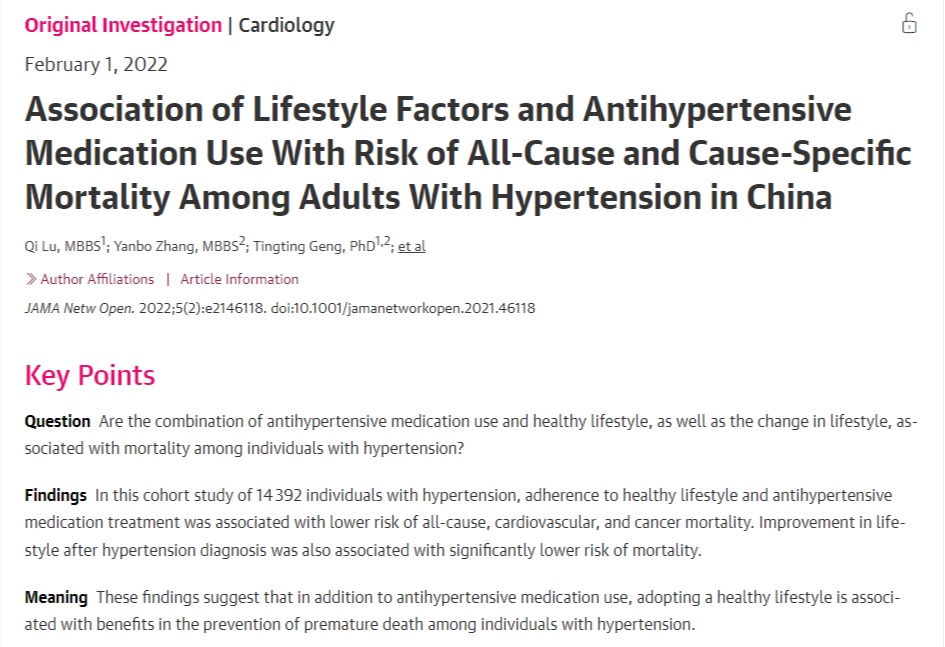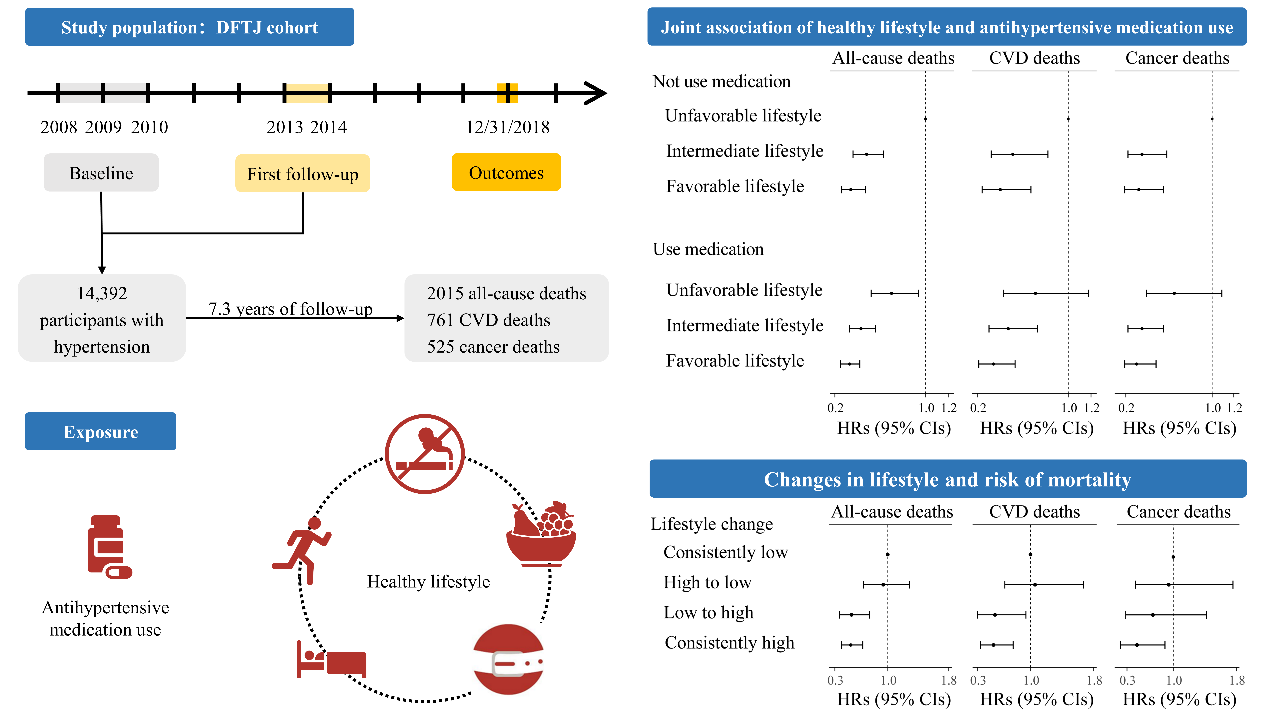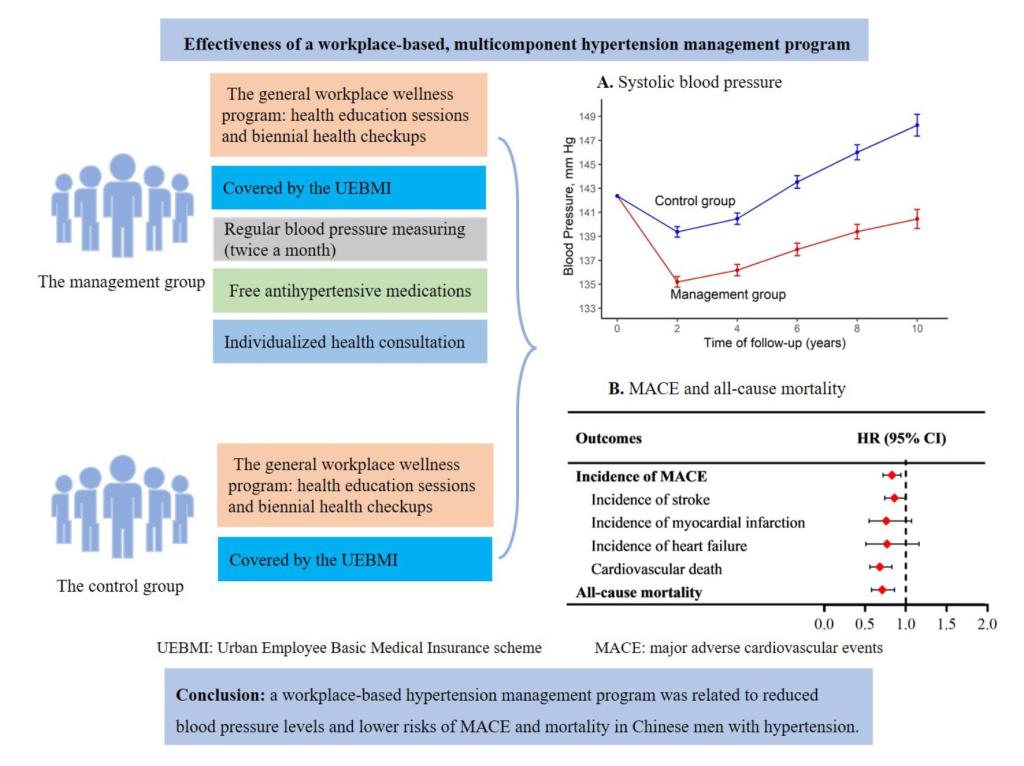Recently, Professor Liu Gang and Professor Pan An's group from the School of Public Health, Tongji Medical College, Huazhong University of Science and Technology, have made new progress in the field of health management of patients with hypertension. The research papers have been published on JAMA Network Open and Hypertension.
On February 1st, a research paper entitled "Association of lifestyle factors and antihypertensive medication use with risk of all-cause and cause specific mortality among adults with hypertension in China" was published online on JAMA Network Open. Ph.D. student Lu Qi is the first author of this paper. Professor Liu Gang and Professor Pan An are the co-corresponding authors.

Hypertension is a major public health problem, affecting 1.13 billion adults worldwide in 2015. Elevated blood pressure is a leading cause of cardiovascular disease (CVD) and mortality, which accounted for over 10 million deaths in 2019. Therefore, it is paramount to identify effective strategies to prevent or delay poor prognosis for individuals with hypertension. Adherence to antihypertensive medication treatment and following a healthy lifestyle (smoking cessation, moderate alcohol intake, weight control, exercise, and healthy diet) are important parts of hypertension self-management. However, non-adherence to medication, or simply relying on medication, while ignoring the role of healthy lifestyle, is a widespread phenomenon. These are important risk factors for poor blood pressure control and subsequent cardiovascular events. In addition, the evidence regarding the long-term health effects of the combination of antihypertensive medication use and healthy lifestyle among individuals with hypertension is limited.
The research team used data of the Dongfeng-Tongji cohort, an ongoing dynamic cohort that consecutively recruits retired employees of Dongfeng Motor Corporation, Shiyan City, China. A total of 14,392 participants with hypertension were finally included. During a median follow-up of 7.3 years, 2,015 deaths were documented, including 761 cardiovascular deaths and 525 cancer deaths. After adjustment for key demographic characteristics, hypertension duration, blood pressure, common comorbidities, uses of hypoglycemic and lipid-lowing medication, metabolic biomarkers, and mental stress, compared with individuals not using antihypertensive medication and following an unfavorable lifestyle, the combination of using antihypertensive medication and adhering to a favorable lifestyle was significantly associated with the lowest risk of all-cause mortality (hazard ratio [HR], 0.32; 95% CI,0.25-0.42), CVD mortality (HR, 0.33, 95%CI, 0.21-0.53), and cancer mortality (HR, 0.30; 95%CI, 0.19-0.47). Furthermore, compared with the reference group, participants without antihypertensive medication treatment but who adopted a favorable lifestyle had lower risks of all-cause mortality (HR, 0.34; 95%CI, 0.25-0.46), CVD mortality (HR, 0.40; 95%CI, 0.24-0.67), and cancer mortality (HR, 0.33; 95%CI, 0.19-0.55); whereas those using antihypertensive medication but following an unfavorable lifestyle had no significant reduction in risk of CVD mortality (HR, 0.71; 95%CI, 0.43-1.17) or cancer mortality (HR, 0.64; 95%CI, 0.38-1.07). In addition, improvement in lifestyle after hypertension diagnosis was also significantly associated with lower risk of all-cause and cause-specific mortality. These findings further support that, in addition to antihypertensive medication use, adopting a healthy lifestyle is associated with benefits in the prevention of premature death among individuals with hypertension.

On December 8th, 2021, the team collaborated on the publication in Hypertension, entitled "Effectiveness of a Workplace-Based, Multicomponent Hypertension Management Program in Real-World Practice: A Propensity-Matched Analysis." Zhou Yanfeng, Chen Simiao, and Wang Guodong are co-first authors, and Pan An, Wu Shouling, and Liu Gang are co-corresponding authors.
Pharmaceutical treatment and lifestyle modifications have been demonstrated to be effective in reducing blood pressure (BP) and CVD risk, but rates of hypertension control in China are generally low. Within the Kailuan study, a workplace-based hypertension management program was initiated in 2009 among men with hypertension, which included regular BP measuring (twice a month), free antihypertensive medications, and individualized health consultation. Participants were followed until loss-to-follow-up, death, or December 31st, 2019. Both systolic and diastolic BPs were significantly lower in the management group than in the control group over follow-up, and the mean between-group difference at the 10th year was -7.83 (95% CI, -9.06 to -6.62) mm Hg for systolic BP and -4.72 (95% CI, -5.46 to -3.97) mm Hg for diastolic BP. The BP control rate showed a significant increase in the first two years and continued to maintain steady during the follow-up periods. Compared with the BP control rate of 36.3% in the control group, the BP control rate reached 49.2% in the management group, and the management group had higher odds of achieving BP control (odds ratio [OR], 1.70; 95% CI, 1.41 to 2.06) at the 10th year. The management program was related to a 17% reduced risk of MACE (HR 0.83; 95% CI, 0.72 to 0.94), 14% reduced risk of stroke (HR 0.86; 95% CI, 0.74 to 0.99), 32% reduced risk of CVD mortality (HR 0.68; 95% CI, 0.56 to 0.83), and 29% reduced risk of all-cause mortality (HR, 0.71; 95% CI, 0.58 to 0.86); but the association with risks of MI (HR, 0.76; 95% CI, 0.55 to 1.07) and HF (HR, 0.77; 95% CI, 0.51 to 1.16) did not achieve statistical significance.

Source: School of Public Health, Tongji Medical College, HUST
Written by: Lu Qi
Edited by: Lu Yizhong, Scott, Jiang Jing

